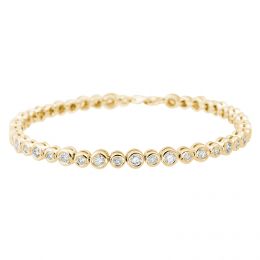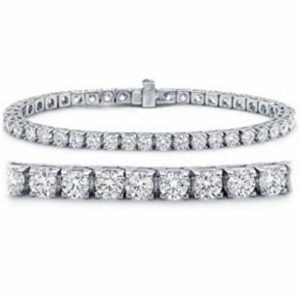
What are Tennis Bracelets? History & Background
Any flexible bracelet made of metal, (connected by a thin, precious metal chain,) generally gold or platinum and set with diamonds and / or gemstones around the whole band can be referred to as a tennis bracelet. The bracelet sits close to the wrist making it comfortable to wear. The original name was line bracelets, which is still commonly used. The name change was adopted after the 1987 US open tennis tournament. Chris Evert’s diamond line bracelet broke during her match, she asked the officials to stop play, so she could retrieve the diamonds. Since that day, the line diamond bracelet has also been referred to as the tennis bracelet.
Buying Diamond Tennis Bracelets:
Here are some tips on what to think about when shopping for a tennis bracelet.
Choosing the Right Tennis Bracelet
Consider how often you plan to wear it. If it will only be worn for special occasions, go for larger or more expensive stones set in 18ct gold or platinum. Or for regular wear, perhaps a less expensive design with fewer / smaller stones set in 9ct or 14ct gold. Make sure the mounts and the diamonds are smooth, in order to avoid snagging.
Set a Budget
Decide how much you can afford to spend and then look at what is available within your budget.
Learn the 4 C’s of Diamonds
The Gemological Institute of America rates the quality of a diamond based on the Four C’s: cut, colour, clarity, and carat.
Cut: A well-cut diamond is one that has ideal proportions and exhibits a lot of light and brilliance.
Clarity: Refers to the number of imperfections in the diamond, from flawless to those with obvious natural defects.
Colour: While perfectly colourless diamonds are popular, these will be graded from D (the whitest), through to Z, (yellow.) Novelty coloured diamonds might be fun in a tennis bracelets.
Carat: The weight or size of the diamond. With tennis bracelets and other diamond jewellery with multiple stones, product information will usually list the total diamond carat size in the entire bracelet or piece, rather than each individual diamond carat size.

Choose Your Favourite Metal
You can choose between platinum, yellow gold, white gold, rose gold and even sterling silver. Yellow gold has a classic look, whilst white and rose gold are more modern. 9K, 14K or 18K gold are durable enough for everyday wear, as is platinum. Platinum is rarer, and therefore more expensive. It has a similar appearance to white gold but is heavier and the colour lasts longer. (However, white gold can be re-plated to bring back its whiteness and shine.)
Keep in mind that there is a trade-off between durability and price. Yellow gold and silver are softer and will suffer more wear and tear. However, they are a good and affordable choice if you are not going to wear the bracelet every day. More durable alternatives such as platinum are more expensive but will allow you to wear your tennis bracelet more often without being afraid that its parts will wear out quickly and break. White gold is a good middle-ground choice as it is more durable than yellow gold but not as expensive as platinum.
It is not always necessary to have diamonds of top-grade colour in your bracelet, though. For example, if you are shopping for a gold tennis bracelet, stones with a slight yellow tint will blend with the yellow gold and become less noticeable, making the white in the diamonds stand out. If you are buying a white metal bracelet, the diamonds really do need to be virtually colourless, as any yellow tints will stand out against the white backdrop.
Diamond Colour
It’s up to you of course! There are all sorts of options, sometimes you’ll even see white diamonds and coloured diamonds set together in the same bracelet, giving a contemporary look. Generally, the whiter the diamonds in your bracelet, the higher quality their colour is and therefore the more expensive the price. Fancy-colour diamonds being rare will generally be expensive, dependant on strength of colour and clarity.
Diamond Clarity
When it comes to tennis bracelets, clarity is not as important as colour for a simple reason: The diamonds in these pieces are too small for most of their flaws to be visible with the naked eye, unless you look from a very close distance or with a diamond loupe.
Size matters for clarity.
Bear in mind, that clarity matters more with bigger stones. The inclusions (flaws) in larger stones are simply more visible, so when choosing a tennis bracelet with bigger diamonds, make sure they don’t have defects that can be easily seen with the naked eye.
Uniformity is important
Whatever the exact grade of your diamonds’ colour, it is much more important that it be same for all stones. You don’t want a tennis bracelet that looks like a patchwork of randomly ordered white and yellowish diamonds.
Check the diamonds for damage
Look closely at the stones, preferably with a jeweller’s loupe, and inspect them for chips and cracks. You don’t want to buy a bracelet with damaged diamonds – once their integrity has been compromised, they are more likely to break further.
The Structure of the Tennis Bracelet
Generally, the structure of your tennis bracelet should be sturdy enough to make the piece safe to wear and protect it from hits, blows, bumps, etc.
Diamond settings: Check how the individual diamonds are mounted in the bracelet. Settings should be secure and should offer some protection against hits.
Links: Look at the links of the tennis bracelet – they should be robust and not easy to break in case the bracelet is pulled hard. Make sure there are no twists or cracks between the stones.
Clasp: Test the clasp to make sure it closes safely and does not open easily. It should be solid and not feeble to not bend or break.
Flexibility: You need some flexibility as a too rigid bracelet could break easily whenever you twist it (which happens often when wearing such pieces). To test the bracelet’s flexibility, dangle it, and see if it hangs straight in the air without kinking.
For the diamonds, you’ll want to look at them closely with the naked eye. They need not be graded as the diamonds in tennis bracelets are too many and too small to make the expense of grading each one individually worthwhile. For example, if you were to certify 55 diamonds in a tennis bracelet, the certifications would cost almost five thousand dollars alone. Because there are no certifications for most tennis bracelet diamonds, it’s especially important to buy a tennis bracelet from a thoroughly vetted, reputable vendor. Much of what you are paying for in a tennis bracelet is craftsmanship and style.
Overall in reviewing the diamonds yourself, make sure they offer brilliance- meaning light reflects back to the eye, creating sparkle. You’ll also want to ensure the diamonds look eye clean (meaning they don’t have any noticeable blemishes) and that the stones look white in relation to the setting.

